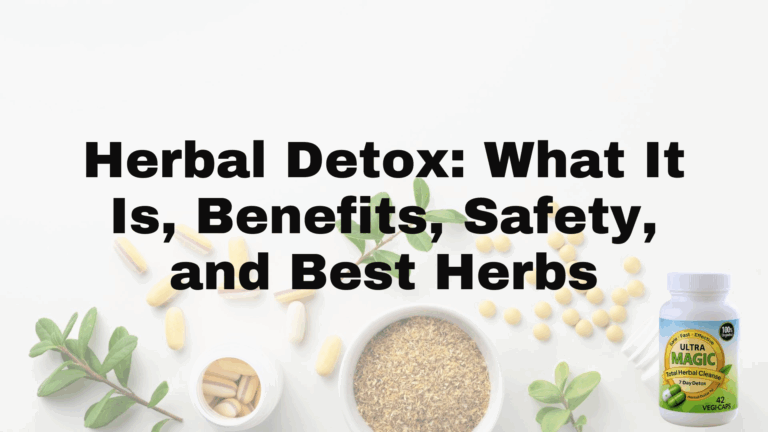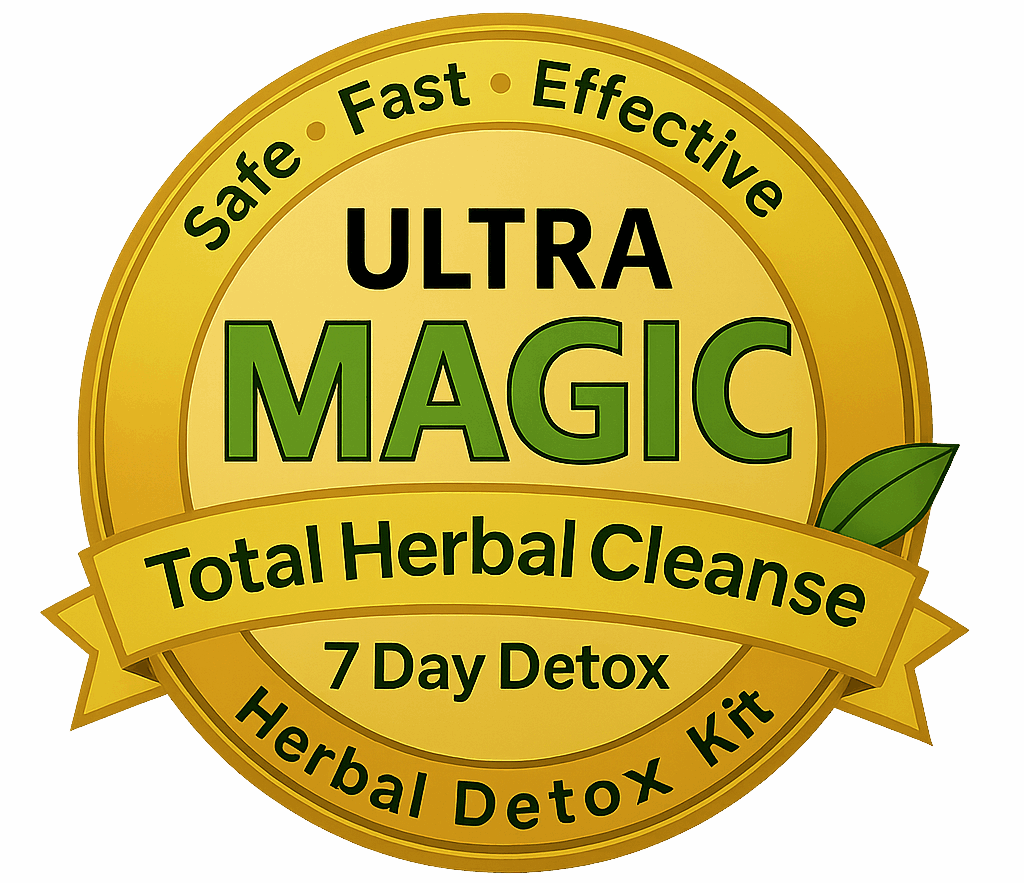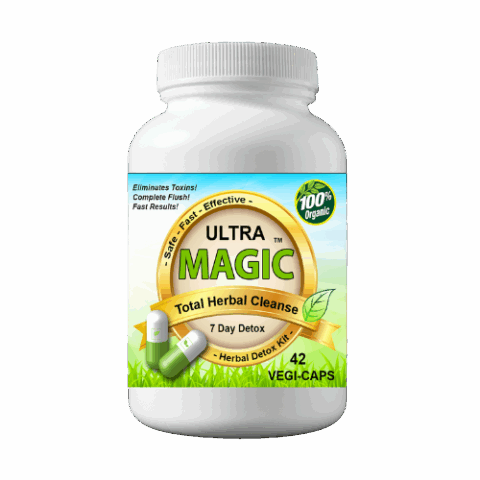
Herbal Detox: What It Is, Benefits, Safety, and Best Herbs
Herbal detox means using targeted plants—think dandelion, milk thistle, burdock, and more—to nudge your liver, kidneys, lymph, and digestive tract so they process and expel built-up chemicals more efficiently. Unlike juice fasts that simply starve you of calories, botanical formulas supply nutrients and phytochemicals that work with liver enzymes, stimulate bile flow, increase urine volume, and keep the bowels moving.
This guide strips away the noise: you’ll get the science-backed and the speculative benefits, safety red flags, the 12 herbs practitioners use most, and step-by-step advice—from choosing tea versus capsules to running a clean seven-day protocol. We’ll compare high-potency blends like Magic Detox™ with convenience-store quick fixes so you can separate evidence from hype. By the end, you’ll know whether a gentle daily tea or a maximum-strength, week-long program fits your body, schedule, and toxin load. Ready to get clear? Let’s begin.
How Herbal Detox Differs From Other Cleanses
Juice fasts, lemonade “master” cleanses, colon hydrotherapy, water-only fasting—the detox shelf is crowded, yet most of these methods revolve around restriction. Calories drop, fiber disappears, and any benefit often comes from brief digestive rest rather than true toxin removal. An herbal detox works the opposite way: it adds targeted phytonutrients that light up Phase I and Phase II liver enzymes, coax extra bile out of the gallbladder, increase urinary flow, and keep stools moving so waste has an exit ramp. In other words, plants partner with the body’s in-house filtration system instead of sidelining it. Another key difference is time horizon. Same-day “flush” drinks cause a rapid purge; herbal protocols are usually taken over days or weeks to nourish and rehabilitate organs for lasting resilience.
Key Definitions to Know
- Detox vs. cleanse: Detox focuses on biochemical transformation of toxins; cleanse usually means mechanical removal (think colon cleanse).
- Flush: A very short, aggressive purge—often laxative-based.
- Tonic: Gentle, daily support to maintain organ tone.
- Whole herb vs. extract: Powdered plant parts retain all constituents; standardized extracts concentrate one marker compound for predictable potency.
Types of Herbal Detox Approaches
- Single-herb spotlight – Milk thistle seed for liver enzyme balance or cilantro for heavy-metal binding.
- Multi-herb blends – Formulas like dandelion + burdock + ginger that cover liver, lymph, and gut in one capsule or tea.
- Organ-focused kits – Separate tinctures for liver, kidneys, and colon taken in sequence.
- Traditional systems – Ayurveda’s Triphala for bowel tone or Chinese bitters to spark digestive Qi.
- Full-body protocols – Comprehensive programs such as a 7-day Magic Detox™ course aimed at simultaneous urine, blood, and digestive cleansing.
How Your Body Naturally Detoxifies—And Where Herbs Fit In
Long before anyone brewed a “detox tea,” your body came equipped with a sophisticated waste-management crew. The liver breaks toxins down in two enzyme-driven phases, packages them into bile, and ships that bile to the intestines. Kidneys filter about 150 quarts of blood daily, deciding what stays and what goes into urine. Lymph fluid gathers cellular debris, the colon carries it out, your lungs off-gas volatile compounds, and skin vents excess heat and trace metals through sweat.
Problems start when modern life—processed food, heavy alcohol use, prescription meds, or recreational drugs—outpaces these pathways. Nutrient gaps slow Phase II liver conjugation; dehydration thickens bile; sluggish bowels reabsorb what should be exiting. An herbal detox doesn’t override these systems; it supplies phytochemicals that nudge each organ back to factory settings.
Common herbal actions and their targets:
- Cholagogues (dandelion root, artichoke leaf) – thin and move bile for smoother fat digestion.
- Alteratives (burdock, red clover) – support blood and lymph circulation.
- Diuretics (nettle, parsley) – gently increase urine flow.
- Laxatives (rhubarb, Triphala) – keep the colon on schedule.
- Diaphoretics (ginger, yarrow) – encourage a healthy sweat during exercise or sauna sessions.
Evidence Snapshot
Small human trials show milk thistle normalizing ALT/AST liver enzymes after alcohol overload; animal models demonstrate dandelion root increasing antioxidant glutathione and burdock reducing lead accumulation in tissues. A pilot study of cilantro-chlorella combos recorded higher urinary mercury excretion. Results are promising yet preliminary—dose, duration, and individual genetics all matter.
Myth-Busting: What Herbs Cannot Do
No plant can reverse years of ultraprocessed food or guarantee overnight weight loss. Herbs won’t “delete” all drug metabolites in an hour, nor can they cure chronic disease without lifestyle changes. View them as targeted assistants—powerful, yes, but still part of a broader plan that includes clean water, fiber-rich meals, movement, and adequate sleep.
Proven and Claimed Benefits of Herbal Detox
People turn to an herbal detox for three main reasons: to feel lighter, look clearer, and test cleaner. Some advantages are backed by pilot trials and traditional pharmacognosy, while others remain hopeful word-of-mouth. Below you’ll find the most talked-about benefits, with quick notes on the strength of the evidence so you can set realistic goals before starting any program.
Digestive and Liver Support
A well-built formula rich in bitters—dandelion root, milk thistle seed, burdock—can:
- Stimulate bile flow, easing fat digestion and reducing the “brick in the gut” feeling after heavy meals (traditional + small human studies).
- Normalize mildly elevated liver enzymes (ALT/AST) in alcohol users or those on multiple medications (early clinical data).
- Relieve occasional constipation by pairing bitter cholagogues with gentle laxatives like Triphala (traditional use).
Users often report less bloating within three to five days, which is consistent with faster gastric emptying and better bile circulation.
Metabolic and Weight-Related Effects
Weight-loss claims around herbal detoxes are often inflated. What’s more realistic:
- Short-term water weight reduction from mild diuretics such as nettle and parsley (well-documented).
- Improved insulin sensitivity from burdock polysaccharides and cinnamon’s polyphenols, potentially curbing post-meal glucose spikes (animal and early human data).
- A subtle uptick in resting metabolic rate when pungent spices like ginger and turmeric raise thermogenesis (small, mixed studies).
True fat loss still hinges on diet and activity; herbs simply create a friendlier metabolic terrain.
Skin, Energy, and Immune Health
When elimination pathways run smoothly, by-products that can inflame skin or drain vitality leave more efficiently:
- Fewer acne flares and calmer eczema, attributed to lowered systemic inflammation from antioxidants in red clover, nettle, and turmeric (traditional + observational).
- Steadier energy as sluggish liver detox frees up micronutrients needed for mitochondrial function (plausible mechanism, limited trials).
- Modest immune modulation—cat’s claw and Pau d’Arco contain alkaloids and naphthoquinones studied for supporting normal white-cell activity (in-vitro and animal research).
While results vary, many users notice clearer skin and brighter mornings by week two.
Drug-Related Toxin Clearance
For people facing a nicotine or drug screen, an herbal detox offers multi-pathway support:
- Increased urinary output (nettle, dandelion leaf) can speed metabolite dilution.
- Enhanced Phase II conjugation from milk thistle’s silymarin and cilantro’s heavy-metal binding may shorten the half-life of certain compounds.
- Added fiber or laxative herbs reduce enterohepatic recirculation, giving metabolites fewer chances to re-enter the bloodstream.
Important: Herbs cannot rewrite your pharmacokinetics. Success still depends on timing, body fat percentage, and the product’s potency. High-strength, full-spectrum blends like Magic Detox™ stack multiple actions—liver support, diuresis, bowel motility—to maximize the odds, but no method is foolproof.
Safety First: Risks, Contraindications, and Interactions
“Natural” does not mean risk-free. The same alkaloids, bitters, and flavonoids that make an herbal detox effective can also irritate tissue, shift electrolytes, or clash with prescription drugs. Most side effects are mild—think loose stool or frequent urination—but the stakes rise when you’re on medication, pregnant, or managing chronic illness.
Potential trouble spots to review with your practitioner:
- Gastrointestinal distress: strong laxatives (rhubarb, senna) may cause cramping, diarrhea, and potassium loss.
- Allergic reactions: ragweed-sensitive users sometimes react to dandelion or milk thistle (same plant family).
- Blood-thinning overlap: milk thistle and red clover can amplify warfarin, aspirin, or fish-oil effects.
- Diuretic stacking: pairing dandelion with HCTZ or furosemide may dehydrate and deplete minerals.
- Immunomodulators: cat’s claw and Pau d’Arco may counteract corticosteroids or transplant drugs.
- Liver/kidney compromise: concentrated goldenseal or comfrey strains ailing organs and should be skipped.
- Special populations: avoid aggressive detoxes during pregnancy, while breastfeeding, or in children under 12.
How to Use Herbs Responsibly
- Start low, go slow: begin at half dose for two days to gauge tolerance.
- Hydrate: aim for 2–3 L water daily to replace fluids lost via urine, stool, and sweat.
- Watch your outputs: sudden clay-colored stool, dark urine, or persistent nausea means pause and call a doctor.
- Time your meds: separate herbs and prescriptions by at least two hours to reduce absorption conflicts.
- Cycle off: continuous use beyond six weeks can dull efficacy; break for at least one week between rounds.
Regulatory Landscape in the U.S.
Herbal products are sold as dietary supplements, which means the FDA polices safety after a product reaches shelves. Manufacturers are responsible for truth-in-labeling, but there is no pre-market approval. Look for:
- GMP certification and third-party assays for heavy metals, microbes, and active compound levels.
- Transparent milligram amounts; avoid “proprietary blends” that hide dosages.
- Lot numbers and an 800 number—signs a company will actually pick up if something goes wrong.
Due diligence protects your liver and your wallet; treat it as seriously as you would a prescription.
The 12 Best Herbs for Detoxification and How They Work
Below are the plants most often recommended by clinical herbalists and found in research on liver, kidney, and lymph support. Think of the list as a toolbox: each herb has a primary “lane,” yet they overlap enough that you can mix and match for broader coverage. Start with one or two that fit your goal (e.g., liver enzymes, heavy-metal binding) before moving to a multi-herb protocol.
| Herb | Key Actions | Best Form | Typical Dose* | Notable Precautions |
|---|---|---|---|---|
| Dandelion (root + leaf) | Cholagogue, mild diuretic, potassium-rich | Roasted root tea, fresh-freeze capsules | 2–4 g root or 8–10 g leaf daily | Ragweed allergy; watch potassium if on Rx diuretics |
| Milk Thistle (seed) | Phase II liver support, antioxidant | 70% silymarin extract caps | 150–300 mg silymarin 2×/day | May alter warfarin or statin levels |
| Burdock (root) | Alterative for blood/lymph, prebiotic fiber | Decoction, powder | 2–6 g dried root daily | Hypoglycemia risk with diabetes meds |
| Cilantro (leaf) | Heavy-metal chelator, digestive carminative | Fresh pesto, tincture | ¼ cup fresh or 2 ml tincture 3×/day | Mobilizes metals—pair with fiber/binders |
| Red Clover (blossom) | Lymph mover, skin clarifier | Infusion, glycerite | 4–6 g dried flowers daily | Isoflavones may affect estrogen-positive cancers |
| Nettle (leaf) | Nutritive diuretic, mineral replenisher | Hot infusion, capsules | 2–4 g dried leaf 2×/day | Stinging if harvested bare-handed; monitor BP meds |
| Ginger (rhizome) | Digestive stimulant, diaphoretic, anti-nausea | Fresh tea, extract | 1–2 g dried or 5 g fresh daily | Can thin blood at high doses |
| Turmeric/Curcumin | Antioxidant, bile flow, anti-inflammatory | 95% curcumin w/pepper caps | 500 mg curcuminoids 2×/day | Gallstone pain if ducts are blocked |
| Triphala (blend) | Gentle laxative, bowel toner, prebiotic | Powder (“churna”) or caps | 3–5 g at bedtime | Loose stool if overdosed |
| Goldenseal (root) | Bitter liver tonic, antimicrobial | 5% berberine extract | 250 mg 3×/day, short term | Over-harvested; avoid in pregnancy; may raise bilirubin |
| Cat’s Claw (bark) | Immune modulator, anti-inflammatory | Decoction, caps | 20–30 mg oxindole alkaloids daily | Avoid with immunosuppressant drugs |
| Pau d’Arco (bark) | Antifungal, lymph support | Strong tea, tincture | 2–3 g bark 2×/day | May upset stomach; rare anticoagulant effect |
*Doses are for healthy adults; adjust with a qualified professional.
Spotlight: Synergistic Blends
Herbs rarely work in isolation in traditional medicine. Pairing a bitter liver herb with a bowel mover prevents toxins from recirculating. A classic three-way combo is dandelion (bile), milk thistle (hepatocyte protection), and burdock (lymph drainage). For gut sluggishness, many practitioners add Triphala and a pinch of ginger to keep things moving without harsh purging.
Sustainability and Ethical Sourcing
Demand for detox staples has stressed wild populations—goldenseal is now on United Plant Savers’ “At-Risk” list. Choose organically cultivated or fair-trade sources, and favor brands that publish lot numbers and third-party tests. Your liver isn’t detoxed if the forest got trashed in the process.
Forms, Protocols, and DIY vs. Ready-Made Products
Whether you steep loose herbs in your kitchen or swallow a clinical-grade capsule, the end goal of an herbal detox is the same: get active plant compounds into your bloodstream in a reliable dose. The form you choose dictates convenience, potency, taste, and—let’s be honest—how likely you are to stick with the program. A homemade dandelion decoction costs pennies but takes an hour on the stove, while a GMP-certified blend like Magic Detox™ delivers a week’s worth of concentrated extracts in seconds. The sweet spot is picking a delivery method that matches both your schedule and your toxin load.
Pros and Cons of Each Delivery Method
| Form | Upsides | Trade-Offs |
|---|---|---|
| Tea/Infusion | Hydrating, inexpensive, ritualistic | Variable strength, earthy taste, daily prep time |
| Decoction (simmered roots) | Extracts minerals and inulin, good for burdock/dandelion | 20–40 min cook, fridge space, bitter flavor |
| Tincture (alcohol) | Highly bioavailable, long shelf life, easy travel dropper | Alcohol content, costlier per dose |
| Glycerite (alcohol-free) | Kid-friendly, sweet taste | Less concentrated, shorter shelf life |
| Powder/Capsule | Precise dosage, portable, no taste | Swallowing fatigue, fillers possible |
| Standardized Extract Capsule | Maximum potency, research-matched dosing | Higher price, DIY stacking limited |
Sample 7-Day Herbal Detox Plan
Day-by-day outline for an average adult under 220 lbs with moderate toxin exposure:
- Upon waking: 1 capsule high-potency liver blend (dandelion, milk thistle, burdock).
- Breakfast: Protein + fiber meal, 16 oz water.
- Mid-morning: 8 oz nettle–red clover tea.
- Lunch: Colorful salad, healthy fat, 16 oz water.
- Afternoon: 2 ml cilantro tincture + small fruit snack.
- Pre-dinner sweat: 20 min brisk walk or sauna.
- Dinner: Lean protein, cruciferous veggies.
- Bedtime: 1 tsp Triphala powder in warm water for overnight bowel tone.
Repeat for seven consecutive days; scale doses upward by 20 % for heavy users, or choose a ready-made, 7-day kit such as Ultra Magic Detox™ that bundles the above in pre-measured capsules.
Tracking Results
Keep a quick log—paper or phone app—to see what’s working and catch red flags early.
- Energy (1–10)
- Bowel movements (frequency/consistency)
- Bloating or gas
- Skin clarity
- Mood/stress
- Water intake (cups)
Optional labs: baseline and day-8 liver enzymes, C-reactive protein, or a home heavy-metal urine test if metal exposure is suspected. Consistent tracking turns anecdotes into data and helps you refine the next round.
Choosing a Quality Herbal Detox Supplement
The right supplement should list exactly what you’re swallowing—no mystery “detox blend.” Scan the label for:
- Standardized herb extracts with milligram amounts
- USDA-organic or wild-crafted sourcing
- GMP manufacturing and a recent third-party purity test
- A clear return policy (a sign the company trusts its product)
Capsule, Powder, or Liquid? Matching Form to Goal
- Capsules: precise, travel-friendly, ideal for high-strength 7-day programs
- Powders: budget pick, easy to slip into smoothies for long-term maintenance
- Liquids (tincture/glycerite): fastest absorption, useful when digestion is weak
Choose convenience if compliance is your weakness; choose potency if a looming test is the driver.
Product Comparison: How Leading Brands Stack Up
| Brand | Key Herbs | Detox Duration | Strength | Guarantee | Price / Day |
|---|---|---|---|---|---|
| Magic Detox™ | 7 organic herbs | 7-day | Max | 30-day | $4 |
| Same-Day Flush Drink | B-vitamins, sugar | 1 day | High sugar | None | $9 |
| Pharmacy Detox Tea | Senna, hibiscus | 3 days | Gentle | 14-day | $1 |
| Bulk Powder Blend | Milk thistle, fiber | 14 days | Moderate | No | $2 |
Magic Detox™ stands out for combining full-spectrum organ support with a money-back promise.
Red Flags and Marketing Hype to Avoid
- “Lose 10 lbs overnight” or “works in one hour” claims
- Proprietary blends hiding actual dosages
- No contact phone or batch number
- Unrealistic before/after photos obviously Photoshopped
Frequently Asked Questions About Herbal Detox
Still scratching your head? The bite-sized answers below tackle the exact queries people plug into Google every day.
What is an herbal detox?
An herbal detox means taking targeted plants—via tea, capsules, or tincture—to help liver enzymes, urine output, and bowel transit.
It focuses on adding supportive compounds instead of starving the body like many juice or water fasts.
What’s the fastest way to flush toxins out of your body?
Hydration is king: drink enough water for pale-straw urine, then sweat lightly through exercise or sauna.
Mild diuretic herbs like nettle or dandelion leaf can speed things up; harsh laxatives rarely help and risk electrolyte loss.
What is the most powerful natural detoxifier?
No single plant wins every lab test, yet milk thistle’s silymarin consistently shields liver cells from alcohol and medication stress.
For heavy metals, cilantro stands out by binding mercury and lead—especially when paired with fiber or chlorella to escort them out.
Can an herbal detox help me pass a drug test?
Herbs can support faster elimination by boosting bile flow, urination, and stool frequency, which may shorten metabolite detection windows.
Success still hinges on dose, timing, body fat, and test sensitivity; high-potency programs like the 7-day Magic Detox™ stack multiple pathways but aren’t foolproof.
How often should you do an herbal detox?
Most practitioners suggest a gentle, seasonal reset—about four times a year—when diet shifts or toxin exposure rises.
If you vape, smoke, or work with chemicals daily, monthly mini-rounds or a quarterly 7-day intensive may be justified; always pause at least one week between cycles.
Key Takeaways on Herbal Detox
- Herbal detox means adding targeted plants—dandelion, milk thistle, burdock, nettle, and more—to amplify your liver, kidney, lymph, bowel, and skin elimination routes.
- Realistic benefits include lighter digestion, normalized liver enzymes, clearer skin, and modest help moving drug or heavy-metal residues. Instant weight-loss miracles and “overnight toxin erasure” remain marketing fiction.
- Safety matters: start low, stay hydrated, watch interactions (warfarin, diuretics, immunosuppressants), and skip aggressive protocols if you’re pregnant, nursing, or have serious liver/kidney disease.
- The “best” herbs work in concert; bitters for bile, laxatives for exit, diuretics for flow, and antioxidants for cell defense. Quality counts—look for organic sourcing, standardized extracts, GMP labels, and transparent milligrams.
- Choose a format you’ll actually use: teas cultivate daily ritual, tinctures absorb fast, capsules deliver clinical doses for tight deadlines.
- Pair any detox with fiber-rich meals, movement, deep sleep, and stress management to lock in results.
Ready for a week-long, maximum-strength protocol that ticks every box? Explore Magic Detox™ at magicdetox.com and see if its 7-day permanent cleanse fits your goals.



